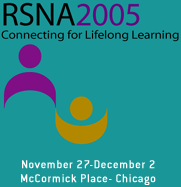
Abstract Archives of the RSNA, 2005
SSC05-06
A Novel Method for Radiation Dose Assessment in Adult Cardiac Catheterization and Gated CT Angiography Using MOSFET Technology
Scientific Papers
Presented on November 28, 2005
Presented as part of SSC05: Cardiac (Multimodality)
Geoffrey Kunz MD, Presenter: Nothing to Disclose
Terry T. Yoshizumi PhD, Abstract Co-Author: Nothing to Disclose
Lynne Hurwitz MD, Abstract Co-Author: Nothing to Disclose
Michael Sketch MD, Abstract Co-Author: Nothing to Disclose
Donald Paul Frush MD, Abstract Co-Author: Nothing to Disclose
Greta Toncheva MS, Abstract Co-Author: Nothing to Disclose
Giao Nguyen MS, Abstract Co-Author: Nothing to Disclose
Thomas Bashore MD, Abstract Co-Author: Nothing to Disclose
et al, Abstract Co-Author: Nothing to Disclose
To determine radiation dose rates during fluoroscopy and cineangiography and to measure the effective dose (ED) during simulation of a typical diagnostic cardiac catheterization in order to compare these doses to those obtained during gated CT angiography (CTA).
Twenty organs were monitored with MOSFET detectors (Thomson-Nielson) using an anthropomorphic adult female phantom (CIRS). All detectors were calibrated using an Integris Allura cardiac cath unit (Philips). Mean fluoro and cine dose rates at a given projection angle were determined by taking three exposure runs. To simulate a typical cardiac cath, average fluoro and cine times for each projection were determined from observation of diagnostic catheterizations at our institution. Organ doses were computed by multiplying dose rate and exposure time, and ED (ICRP 60) from combined fluoro and cine runs were obtained by summing each projection data. Gated cardiac doses were measured in the same phantom with identical MOSFET placement during gated cardiac CTA (16 slice LightSpeed, GE Healthcare) simulated for a heart rate of 60 bpm using the following imaging parameters: kVp of 120, 320 mA, rotation time of 0.5 sec, collimation of 16 x 0.625.
During a typical cardiac catheterization, the highest total organ doses were seen in the thoracic spine marrow (4.89±0.25 cGy), and esophagus (6.52±0.16 cGy). Using these and the other organ doses, the ED for fluoro was 6.44±0.10 mSv and for cine was 2.20±0.11 mSv, yielding a combined fluoro + cine procedure of 8.64±0.15 mSv. For gated CTA, the effective dose was 21.96 mSv.
This study has established baseline organ-specific radiation dosimetry for a typical diagnostic cardiac catheterization. Additionally, data from projection-specific measurements will allow accurate dose calculations for other cath lab procedures, such as coronary intervention or arrhythmia ablation. The ED for non modulated gated cardiac CTA is substantially greater than routine cardiac catheterization.
D.P.F.: GE Healthcare Research Support and Medical Advisor
Kunz, G,
Yoshizumi, T,
Hurwitz, L,
Sketch, M,
Frush, D,
Toncheva, G,
Nguyen, G,
Bashore, T,
et al, ,
A Novel Method for Radiation Dose Assessment in Adult Cardiac Catheterization and Gated CT Angiography Using MOSFET Technology. Radiological Society of North America 2005 Scientific Assembly and Annual Meeting, November 27 - December 2, 2005 ,Chicago IL.
http://archive.rsna.org/2005/4418331.html

